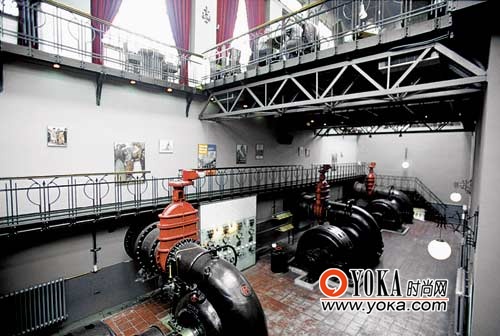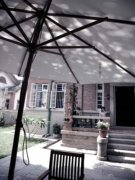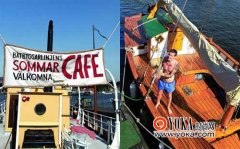A coffee shop converted from a shipbuilding pump house

Three iron cast water pumps that have been kept for almost a hundred years.
Antwerp Het Pomphuis
-Giant pump room
In Europe's second-tier cities, the residents of Antwerp, Belgium have a high ability to accept foreign food culture. The second largest city in Belgium, because of the convenience of the port in the early 15th century, attracted merchants to concentrate on the processing of unpolished diamonds from the world, and later established the world's first stock market. However, the German occupation and destruction in the first and second World Wars and the rise of the neighboring Dutch port of Amsterdam quickly suppressed the development of this port city dominated by entrepot trade and shipbuilding.
Introduced by Belgian friend V, I went to have coffee in an old building next to Ancheng Harbor, which is a mixture of cafe, restaurant and bar converted from shipbuilding pump house. The cafe is called Het Pomphuis, which means The Pump House in Dutch. The pump room, built in 1918, was the largest cast iron pump room in Europe at that time.
Friend V pointed out the food concept of Ancheng people: "the average knowledge level of the people of Antwerp is high. Due to the integration of Dutch, French, German and Flemish cultures, the idea of seeking common ground while reserving differences is deeply rooted in the hearts of the people." And the people, like cities, are burdened with a heavy but rich cultural history into the 21st century, bringing up the idea of pleasure led by food and the power of the continuous outbreak of new food culture. What the small and medium-sized cities in Europe that are still developing have in common is that they can give gourmets with little capital an experimental place to create dreams. "
The Grand Caf é Cafe occupies only the first third of the whole pump room, and the wooden floor in the central part is hollowed out, giving a panoramic view of the pump room. The range of the restaurant begins with the special table VIP on the pump room floor and extends to the innermost dining area. The ceiling was replaced with glass to penetrate into the sun, and the steel-like coldness around the room eased slightly. The coffee shop seats are 7 meters above the pump room and 13 meters high from the ceiling. Overlooking the three iron cast water pumps that have been kept for almost a hundred years, we can see rare green walls and cast iron telephones hanging on the walls. even if the pump no longer makes a loud sound, the vast space seems to solemnly depict the story behind the building. slowly falling into the scene story of the past.
The Nazi German army took advantage of the darkness to occupy the shipyard and the pump room, wreaking havoc and lighting a torch in the bathtub; and forcing everyone to eat near the pump room, forbidding anyone to go beyond that range. The most frightening thing is that the German army dragged the prisoners one by one to the electric room in the pump room at a specified time, which was equipped with a modified electric chair, so they locked the prisoners to the electric chair, and then … Because the plot is too scary, I don't dare to think about it again. Unexpectedly, even more terrible things happened, the coffee shop waiter unexpectedly showed me around the three scenes to reorganize the case, and the only difference is that the motor room has now been converted into a men's and women's bathroom, as most of the old parts of the former motor room are retained. Electronic meter panels, iron plates, barbed wire and electric switches hanging all over the corners appeared on the stage.
Important Notice :
前街咖啡 FrontStreet Coffee has moved to new addredd:
FrontStreet Coffee Address: 315,Donghua East Road,GuangZhou
Tel:020 38364473
- Prev

Quanzhou characteristic Cafe
Green vines, bluestone walls, chestnut wood chairs. It shows the kind of intoxicating and romantic artistic effect. This is also a style pursued by many cafes in Quanzhou.
- Next

The nameless Cafe in Stockholm
The nameless cafe, located on a small dock outside Stockholm's Hyundai gallery (Moderna Museet), opens only in the summer.
Related
- What documents do you need to go through to open a coffee shop? coffee shop coffee shop certificate processing process
- How to purchase Coffee beans in small Cafe how to choose a suitable supplier for domestic Coffee supply Company
- How to drink Starbucks Fragrance White Coffee? how to make Australian White Coffee? what Italian coffee beans are recommended?
- The Story of Flora Coffee: the name of Flora Coffee Bean and the implication of the Flowers on Florna Coffee
- How much does a cup of coffee cost? How much is the profit of a cup of coffee? What is the profit of the coffee shop in a year?
- Yunnan small Coffee, known as "fragrant Coffee", introduces the characteristics of Alpine Arabica Coffee producing areas in Yunnan, China
- 2023 latest Starbucks full menu price list how much is a cup of Starbucks coffee what is better to drink the most popular hot and cold drinks recommended
- Starbucks different kinds of Coffee Price list Starbucks menu 2023 Top Ten Best drinks in Starbucks
- Starbucks Spring praise Comprehensive matching Coffee Bean theme Story Packaging implication and taste description
- The cost of a cup of coffee latte American coffee cost price and selling price

